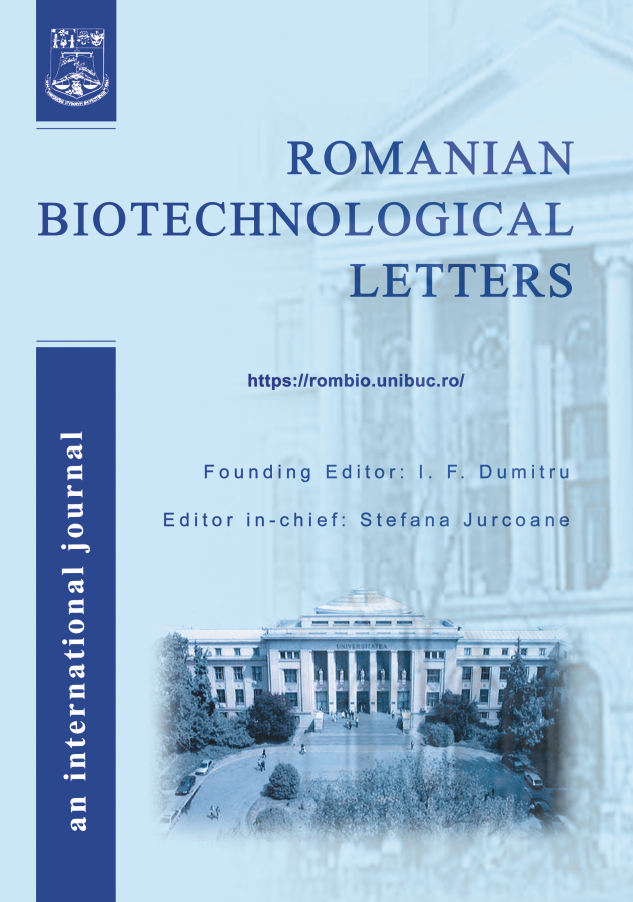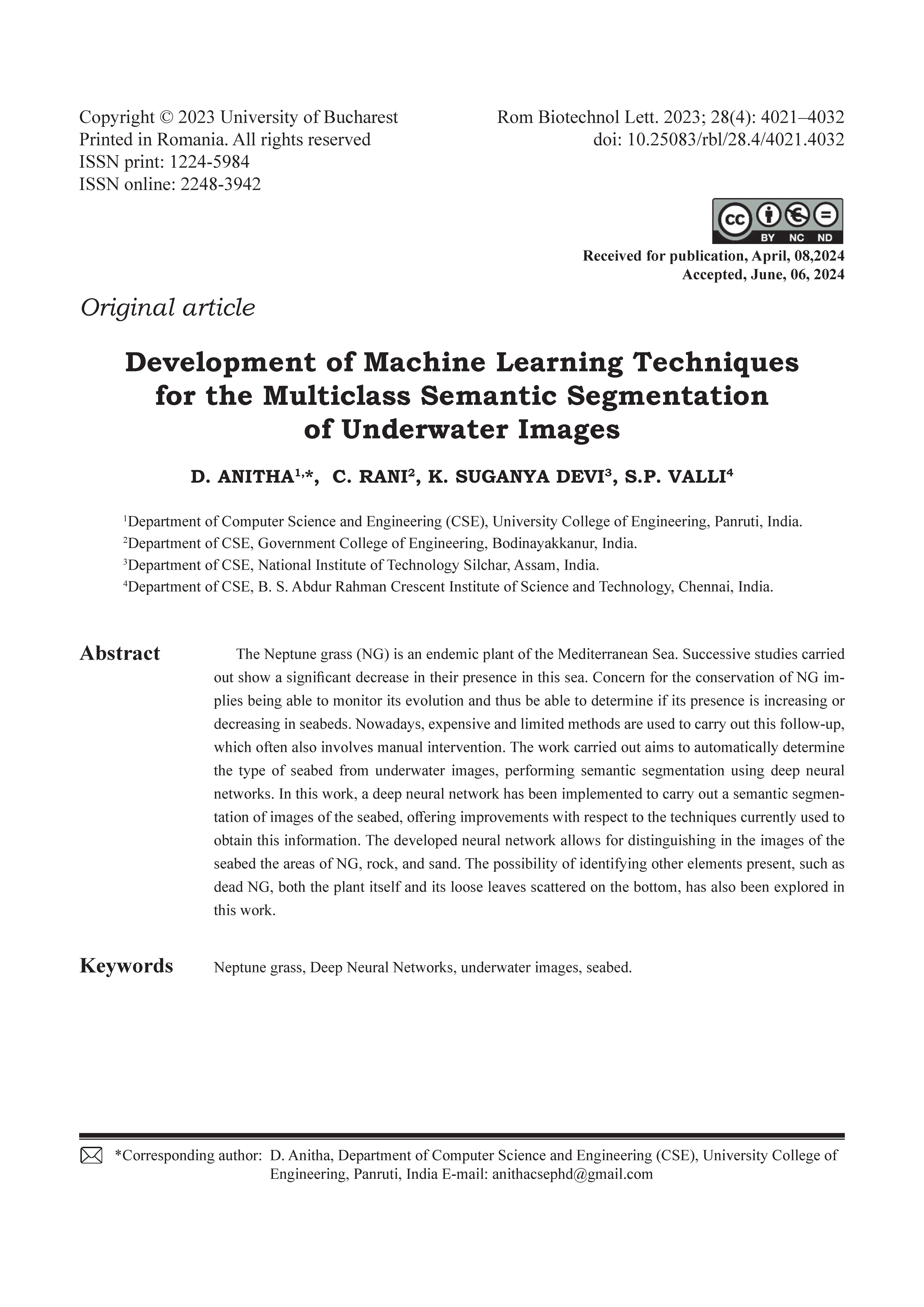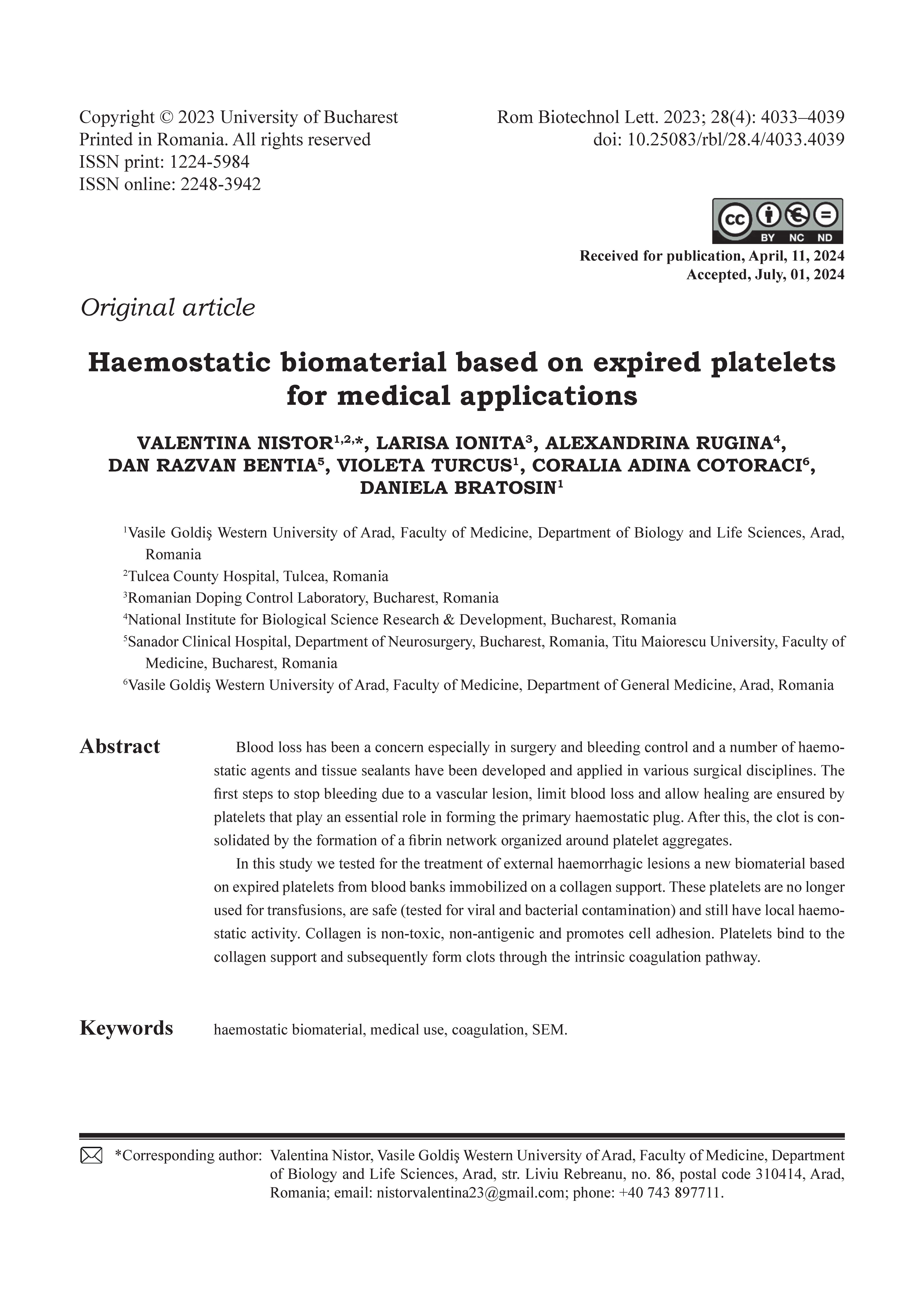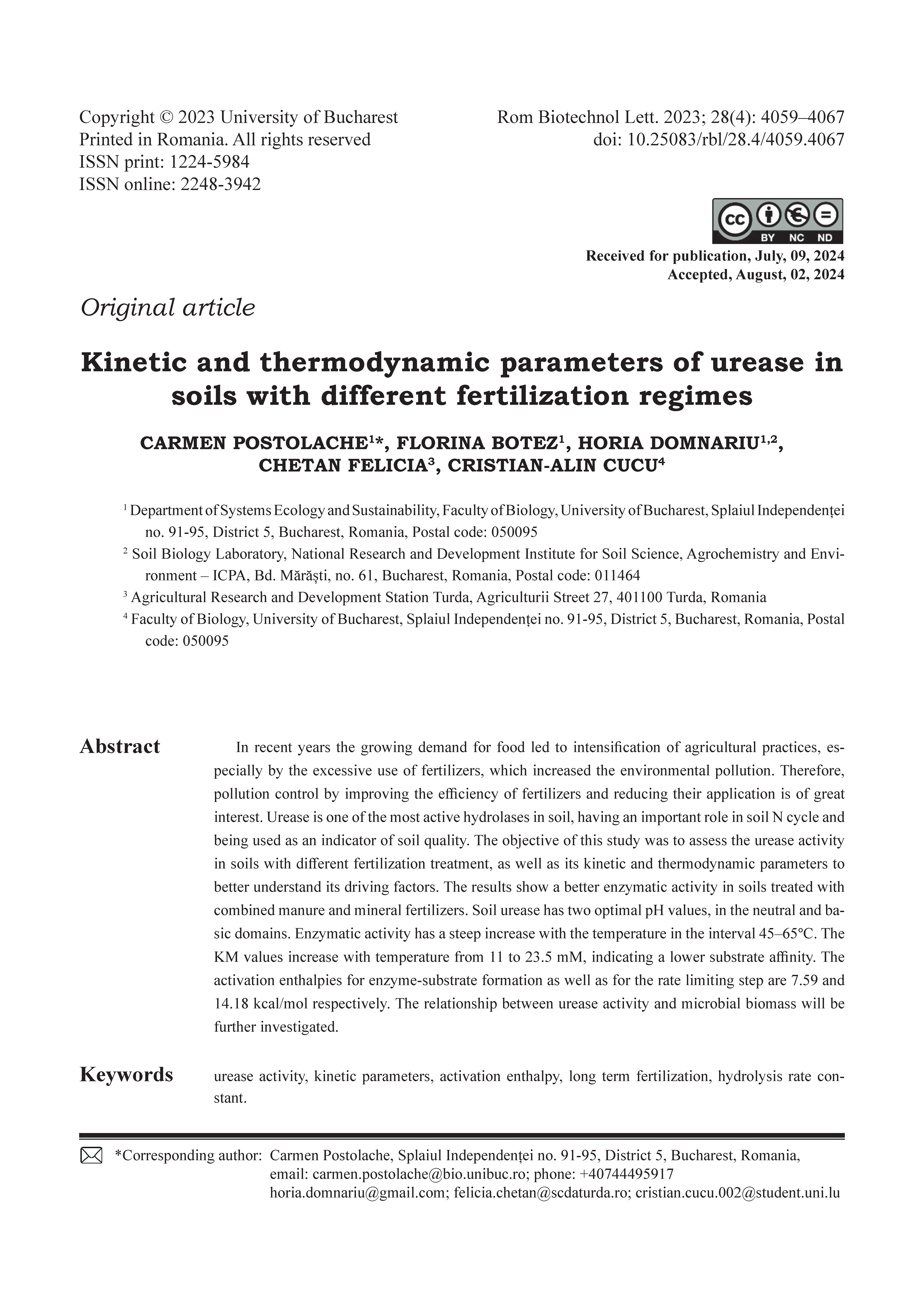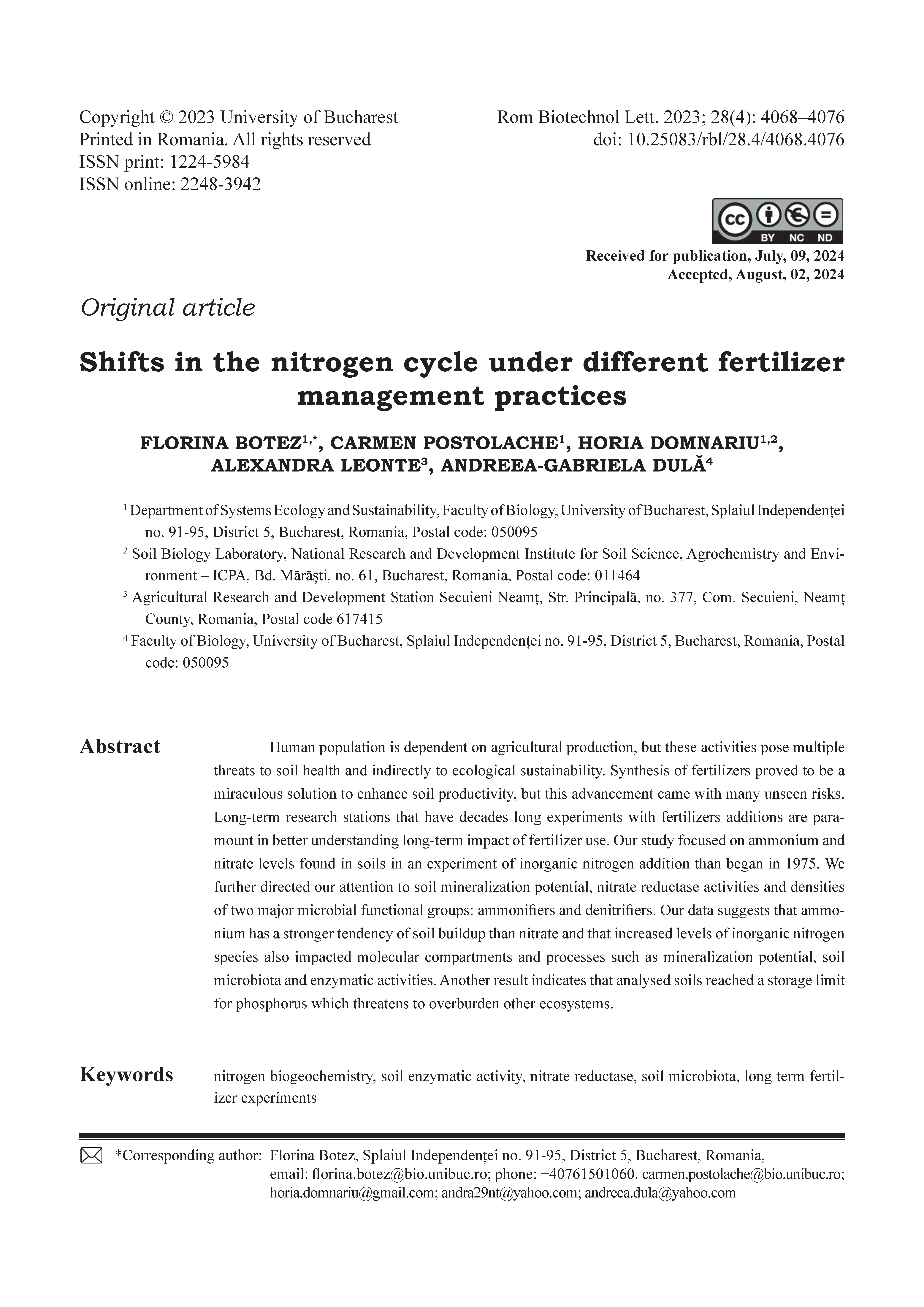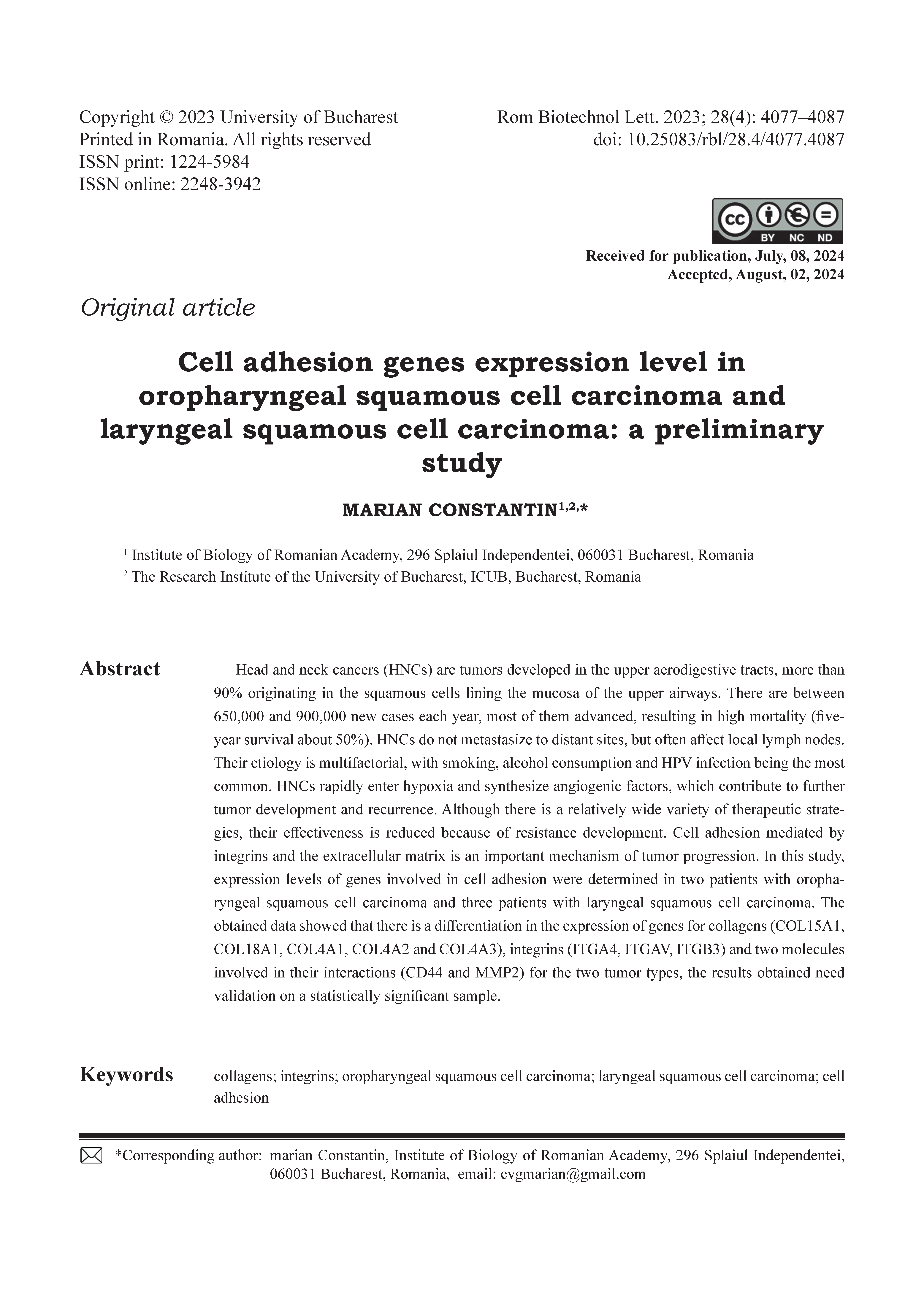Despre revistă
Revista Romanian Biotechnological Letters (RBL) a fost fondată de Prof. IOAN I.F. DUMITRU în anul 2001 sub egida Universității din București, cu suportul Ministerului Educației și Cercetării (UEFISCDI).
RBL este o o revistă Open access cu 6 numere pe an, care publică articole originale, recenzii de literatură, comunicări științifice scurte (de max. 3 pagini) în domeniul biotehnologiilor (verzi, rosii, albe, albastre, bioinformatică) și al cercetării interdisciplinare în medicină, neuroștiințe, agricultură, zootehnie, ecologie și protecția mediului.
Număr curent

This journal is dedicated to publishing original research papers, reviews, rapid and short communications (not exceeding 3 printed pages). The covered topics and subjects include biotechnology (i.e., green, red, white, blue, bioinformatics) and interdisciplinary research in medicine, neuroscience, agriculture, animal husbandry, ecology and environmental protection.
Număr complet
Articles
-
Development of Machine Learning Techniques for the Multiclass Semantic Segmentation of Underwater Images
Rezumat
The Neptune grass (NG) is an endemic plant of the Mediterranean Sea. Successive studies carried out show a significant decrease in their presence in this sea. Concern for the conservation of NG implies being able to monitor its evolution and thus be able to determine if its presence is increasing or decreasing in seabeds. Nowadays, expensive and limited methods are used to carry out this follow-up, which often also involves manual intervention. The work carried out aims to automatically determine the type of seabed from underwater images, performing semantic segmentation using deep neural networks. In this work, a deep neural network has been implemented to carry out a semantic segmentation of images of the seabed, offering improvements with respect to the techniques currently used to obtain this information. The developed neural network allows for distinguishing in the images of the seabed the areas of NG, rock, and sand. The possibility of identifying other elements present, such as dead NG, both the plant itself and its loose leaves scattered on the bottom, has also been explored in this work.
-
Haemostatic biomaterial based on expired platelets for medical applications
Rezumat
Blood loss has been a concern especially in surgery and bleeding control and a number of haemostatic agents and tissue sealants have been developed and applied in various surgical disciplines. The first steps to stop bleeding due to a vascular lesion, limit blood loss and allow healing are ensured by platelets that play an essential role in forming the primary haemostatic plug. After this, the clot is consolidated by the formation of a fibrin network organized around platelet aggregates.
In this study we tested for the treatment of external haemorrhagic lesions a new biomaterial based on expired platelets from blood banks immobilized on a collagen support. These platelets are no longer used for transfusions, are safe (tested for viral and bacterial contamination) and still have local haemostatic activity. Collagen is non-toxic, non-antigenic and promotes cell adhesion. Platelets bind to the collagen support and subsequently form clots through the intrinsic coagulation pathway. -
Microbiological and nutritional quality of banku a fermented maize and cassava-based food consumed in West Africa
Rezumat
Banku is a food made of fermented maize flour and fermented cassava dough. It is produced and consumed by the Togolese, Nigerian and Ghanaian peoples living in Côte d’Ivoire. Not only is this food less known by the original inhabitants of the Côte d’Ivoire but the nutritional and sanitary quality of this food is not defined. However, its preparation remains empirical and is done in unhygienic conditions. Thus, objective of this study is to promote banku through its nutritional and sanitary characteristics in order to ensure consumer safety. Two localities (Grand-Bassam and Gonzagueville) of Côte d’Ivoire where there is a strong foreign community were chosen to take the various samples. The analyses were carried out by biochemical and microbial properties during the production of banku. The results showed that the fermented maize flour had the highest titratable acidity with a value of 0.31 ± 0.01%. The phytate content was lower in the mixture of fermented maize flour and cassava dough with a value of 8.81 ± 0.57 mg/100 g DM. After cooking, the mesophilic aerobic germs load in the banku indicated (5.6 ± 0.4) × 103 CFU/g which is below the standard prescribed by CODINORM. The promotion of banku in Côte d’Ivoire would contribute to food self-sufficiency and growth of the country’s economy. The nutritional and microbiological properties are in accordance with the CODINORM (2001) standard. Banku can be safely consumed in Côte d’Ivoire and worldwide.
-
Antibacterial, Antidiabetic, Antioxidant and DNA cleavage studies of novel N(3-(bis(pyridine-2ylmethyl)amino)-2-hydroxypropyl) benzene sulphonamide ligand
Rezumat
The novel N (3-(bis(pyridine-2ylmethyl)amino)-2-hydroxypropyl) benzene sulphonamide ligand have been synthesized from 1,3-Diamino-propan-2-ol. The structure of the ligand was confirmed by Mass spectroscopy and 1H NMR spectroscopy. The synthesized Schiff base ligand was tested for their in vitro anti bacterial action with Gram-positive and negative bacteria. The anti-diabetic activities have been tested with α-amylase inhibition method and antioxidant effect of the compound was established using DPPH method. Thus all the studies reveals that the synthesised Schiff base compound has significant antibacterial, antidiabetic and antioxidant activities. The DNA cleavage studies shown that, the DNA binding nature of the ligand was appreciably good. The Molecular docking characteristics were supported that the binding approach of the effective inhibitors with the active site of enzymes.
-
Kinetic and thermodynamic parameters of urease in soils with different fertilization regimes
Rezumat
In recent years the growing demand for food led to intensification of agricultural practices, especially by the excessive use of fertilizers, which increased the environmental pollution. Therefore, pollution control by improving the efficiency of fertilizers and reducing their application is of great interest. Urease is one of the most active hydrolases in soil, having an important role in soil N cycle and being used as an indicator of soil quality. The objective of this study was to assess the urease activity in soils with different fertilization treatment, as well as its kinetic and thermodynamic parameters to better understand its driving factors. The results show a better enzymatic activity in soils treated with combined manure and mineral fertilizers. Soil urease has two optimal pH values, in the neutral and basic domains. Enzymatic activity has a steep increase with the temperature in the interval 45–65°C. The KM values increase with temperature from 11 to 23.5 mM, indicating a lower substrate affinity. The activation enthalpies for enzyme-substrate formation as well as for the rate limiting step are 7.59 and 14.18 kcal/mol respectively. The relationship between urease activity and microbial biomass will be further investigated.
-
Shifts in the nitrogen cycle under different fertilizer management practices
Rezumat
Human population is dependent on agricultural production, but these activities pose multiple threats to soil health and indirectly to ecological sustainability. Synthesis of fertilizers proved to be a miraculous solution to enhance soil productivity, but this advancement came with many unseen risks. Long-term research stations that have decades long experiments with fertilizers additions are paramount in better understanding long-term impact of fertilizer use. Our study focused on ammonium and nitrate levels found in soils in an experiment of inorganic nitrogen addition than began in 1975. We further directed our attention to soil mineralization potential, nitrate reductase activities and densities of two major microbial functional groups: ammonifiers and denitrifiers. Our data suggests that ammonium has a stronger tendency of soil buildup than nitrate and that increased levels of inorganic nitrogen species also impacted molecular compartments and processes such as mineralization potential, soil microbiota and enzymatic activities. Another result indicates that analysed soils reached a storage limit for phosphorus which threatens to overburden other ecosystems.
-
Cell adhesion genes expression level in oropharyngeal squamous cell carcinoma and laryngeal squamous cell carcinoma: a preliminary study
Rezumat
Head and neck cancers (HNCs) are tumors developed in the upper aerodigestive tracts, more than 90% originating in the squamous cells lining the mucosa of the upper airways. There are between 650,000 and 900,000 new cases each year, most of them advanced, resulting in high mortality (five-year survival about 50%). HNCs do not metastasize to distant sites, but often affect local lymph nodes. Their etiology is multifactorial, with smoking, alcohol consumption and HPV infection being the most common. HNCs rapidly enter hypoxia and synthesize angiogenic factors, which contribute to further tumor development and recurrence. Although there is a relatively wide variety of therapeutic strategies, their effectiveness is reduced because of resistance development. Cell adhesion mediated by integrins and the extracellular matrix is an important mechanism of tumor progression. In this study, expression levels of genes involved in cell adhesion were determined in two patients with oropharyngeal squamous cell carcinoma and three patients with laryngeal squamous cell carcinoma. The obtained data showed that there is a differentiation in the expression of genes for collagens (COL15A1, COL18A1, COL4A1, COL4A2 and COL4A3), integrins (ITGA4, ITGAV, ITGB3) and two molecules involved in their interactions (CD44 and MMP2) for the two tumor types, the results obtained need validation on a statistically significant sample.
